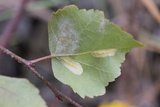Phyllonorycter ulmifoliella (Hübner, [1817]) Species
Last modified: Dec. 10, 2025, 6:12 p.m.
One of the most common Phyllonorycter-species in Belgium, since long recorded from all provinces, sometimes very plentiful.
Details
- Classification
- Family: Gracillariidae > Subfamily: Lithocolletinae > Genus: Phyllonorycter > Species: Phyllonorycter ulmifoliella
- Vernacular names
- Berkenvouwmot (NL), Red birch midget (EN), Gemeine Birken-Faltenminiermotte (DE)
- First mention in Belgium
- De Sélys-Longchamps E. 1844. Énumération des insectes Lépidoptères de la Belgique. — Mémoires de la Société royale des Sciences de Liége 2: 1–35. On page 25 (as Elachista ulmifoliella H.). view page
- Status
-
Native
Distribution
Imago
Head ochreous brown; forewing ground colour golden to reddish brown; white pattern consisting of a straight basal streak, not edged; a yellowish or pure white patch on dorsum near the base; a transversal band finely edged with brown scales; three costal and two dorsal striae, all finely edged with brown scales; a dot of black scales in the apical area.
Caterpillar
Light yellowish green with a light brown head capsule. A conspicuous orange-brown patch on the 6th abdominal segment.
Mine
A rather small, semi-circular, tentiform mine on the underside of a leaf, later growing into an elongated mine situated between two secondary veins. One to six longitudinal folds. On the upper side, the mine is visible as a brown patch. The frass is concentrated in a corner of the mine.
See also gracillariidae.net and bladmineerders.be.
Bionomics
Sometimes many mines on the same leaf. The species hibernates in the pupal stage, between leaf litter on the ground. After the emergence of the adult, the pupal skin protrudes from the mine.
Flight periods
Two generations a year from April towards September, occasionally later.
Observed on
- Host plant (species):
- Betula pendula and Betula pubescens
- Host plant (genera):
- Betula
The species lives on Betula, mainly on Betula pendula, but also on B. pubescens.
Habitat
Mainly on sandy soil, but the species occurs everywhere where Betula species are planted: parks, gardens, road sides, etc.




